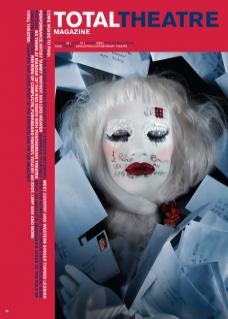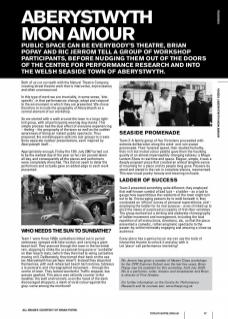Both of us cut our teeth with the Natural Theatre Company, creating street theatre work that is interactive, improvisatory and often unannounced.
In this type of work we are invariably, in some sense, ‘sitespecific’, in that performances change, adapt and respond to the environment in which they are presented. We chose therefore to include the geography of Aberystwyth as a central element of our workshop.
So we started with a walk around the town in a large tightknit group, with all participants wearing dog masks. This simple process had the dual effect of everyone experiencing – feeling – the geography of the town as well as the sudden awareness of being an instant public spectacle. Thus prepared, the workshoppers split into sub-groups to create three separate outdoor presentations, each inspired by Aberystwyth itself…
Appropriately enough, Friday the 13th July 2007 turned out to be the wettest day of the year so far; rain poured down all day, and consequently all the pieces and performers were completely drenched. This did not seem to deter the performers and actually gave an added edge to each work presented.
Who needs the sun to sunbathe?
Team 1 were three 1950s sunbathers kitted out in period swimwear, sprayed with fake suntan, and carrying a giant beach ball. They pranced through the town in the torrential rain, stopping to strike the occasional long pose or ‘sunbathe’ on their beach mats, (which they then had to wring out before moving on!). Deliberately, they turned their back on the sea (as Aberystwyth has perhaps done?). Instead they disported themselves, with well-rehearsed beach ball routines, tableaux a la postcard, and choreographed movement – through the centre of town. They looked wonderful. Traffic stopped, bus queues gawked. This piece was valiantly counter to the weather, the built environment, even the mood of the dank discouraged shoppers, a slash of vivid colour against the grey: verve among the moribund!
Seaside promenade
Team 2: A family group of five Victorians proceeded with extreme deliberation along the wind- and rain-swept promenade. Their funereal speed, their studied formality, their rich but muted colour palette gave them the haunting quality of an almost imperceptibly changing tableau: a Magic Lantern Show in real time and space. Elegiac, simple, it was a deeply poignant piece that created an almost tangible sense of mourning for a place and its people long gone. Passers-by stood and stared in the rain in complete silence, mesmerised. This was visual poetry: beauty and meaning inchoate.
Ladder of success
Team 3 presented something quite different; they employed that well-known symbol of bad luck – a ladder – as a tool to gauge how superstitious the residents of the town might turn out to be. Encouraging passers-by to walk beneath it, they conducted an ‘official’ survey of personal superstitions, and – employing the ladder for its real purpose – even climbed up to elicit the views of surprised occupants of first-floor windows. The group worked out a striking and elaborate choreography of ladder movement and management, including the loud repetition of all instructions, directions, etc, so that the piece presented a comedic, rather enigmatic spectacle to the passer-by, whilst intimately engaging and amusing a close-up audience.
Every place has a genius locus: we can use the tools of interactive theatre to unlock it and play with it. Let ‘place’ call performance into being!
Ric Jerrom has given a number of Master Class workshops for the CPR Summer School over the last few years. Brian Popay was his assistant for this workshop, held July 2007. Ric is a performer, writer, director and broadcaster and Brian is director of Fine Artistes.
For further information on the Centre for Performance Research and its courses see: www.thecpr.org.uk

